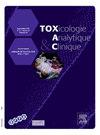Acute thyroid hormone exposures in children: A French Poison Control Centers cohort study
IF 1.8
Q4 TOXICOLOGY
引用次数: 0
Abstract
Purpose
Thyroid hormones are involved in many metabolic and physiological processes, including basal metabolism, thermoregulation, and heart rate; however, there is little information on acute exposure in children, with only a few cases reports or small cases series being available. Our study was undertaken to provide more information about the epidemiological and clinical course of L-thyroxine poisoning in a large pediatric population.
Methods
This multicenter historical cohort study was conducted using data from the French Poison Control Centers on the acute ingestion of thyroid hormone in children (0–18 years of age) between January 2018, 1st and December 2020, 31st.
Results
Of the 2,321 files analyzed, 1,307 cases were included. Toddlers (1–4 years) accounted for 72.8% of the cases. Oral ingestion was unintentional in 96% of the cases. The medicine was from a relative in 97.5% of cases. Only 10 (0.8%) children were symptomatic. No symptoms were reported below a dose of 6.6 μg/kg and some patients remained asymptomatic up to an alleged dose of 500 μg/kg. The symptoms reported were minor, transitory, and limited to tremor, agitation, diarrhea, vomiting, and tachycardia.
Conclusion
Acute L-thyroxine poisoning in children was mainly accidental (unintentional) and has only a few benign symptoms. The clinical outcome is good even if the alleged ingested dose is massive (up to 500 μg/kg).
儿童急性甲状腺激素暴露:法国中毒控制中心队列研究
甲状腺激素参与许多代谢和生理过程,包括基础代谢、体温调节和心率;然而,关于儿童急性接触的信息很少,只有少数病例报告或小病例系列。我们的研究旨在提供更多关于l -甲状腺素中毒的流行病学和临床过程的信息。方法本多中心历史队列研究使用法国毒物控制中心2018年1月1日至2020年12月31日期间0-18岁儿童急性摄入甲状腺激素的数据。结果在分析的2321份文件中,纳入1307例病例。幼儿(1-4岁)占72.8%。在96%的病例中,口服摄入是无意的。97.5%的病例为亲属用药。仅有10例(0.8%)患儿出现症状。剂量低于6.6 μg/kg时未报告任何症状,一些患者在据称剂量达到500 μg/kg时仍无症状。报告的症状轻微、短暂,仅限于震颤、躁动、腹泻、呕吐和心动过速。结论儿童急性左旋甲状腺素中毒以意外(非故意)中毒为主,仅有少数良性症状。即使所谓的摄入剂量很大(高达500 μg/kg),临床效果也很好。
本文章由计算机程序翻译,如有差异,请以英文原文为准。
求助全文
约1分钟内获得全文
求助全文

 求助内容:
求助内容: 应助结果提醒方式:
应助结果提醒方式:


